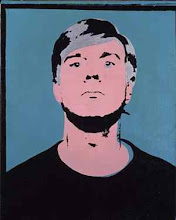 |
| Gustav Metzger, applying hydrochloric acid to nylon sheets - Auto-Destructive Art event, South Bank, London, 1961 |
The social history of the UK in the 1970s is largely defined by industrial disputes - the postal workers' strike (1971), 2 miners' strikes (1972 and 1974), the Grunwick dispute (1976-77) and the public sector workers' strikes remembered as the 'Winter of Discontent' (1978-79). However, no-one much remembers the Art Strike of 1977- 80 called by Gustav Metzer in 1974. The aim was the destruction of capitalism, no less (or the 'art system', at least):
The refusal to labour is the chief weapon of workers fighting the system; artists can use the same weapon. To bring down the art system it is necessary to call for years without art, a period of three years - 1977 to 1980 - when artists will not produce work, sell work, permit work to go on exhibitions, and refuse collaboration with any part of the publicity machinery of the art world… Three years is the minimum period required to cripple the system… In place of the practice of art, people can spend time on the numerous historical, aesthetic and social issues facing art. It will be necessary to construct more equitable forms for marketing, exhibiting and publicising art in the future. As the twentieth century has progressed, capitalism has smothered art - the deep surgery of the years without art will give it a new chance. (Read the full text here.)
In truth, Metzger was probably the only artist actually to withdraw his
labour. While it is easy to scoff at the impracticality of such a gesture,
Metzger's 'career' (or anti-career) stands as a model of sincere and idealistic
commitment.
The following notes are compiled from the writings of John A. Walker -
see refs. at foot of text.
Metzger was born into a Polish-Jewish family in Nuremberg in 1926 where
he was witness to the Nazi rallies. According to Walker he was both impressed
by the spectacle and was left with a life-long suspicion of media manipulation of
the masses. Metzger was sent with his brother to England in 1939; other members
of his family perished in the Holocaust.
Metzger’s interest in art developed through the 1940s and 50s; an early
interest in action Painting (especially Jackson Pollock) evolved into a
practice which combined action with destruction – ‘painting’ with acid onto
nylon so that the ground progressively disintegrated. (Watch a short film
of an action in 1965 here.) He wrote a manifesto ‘Auto-Destructive Art’ in 1959.
Later work experimented with liquid crystals – heat sensitive liquid
crystals were placed between glass slides inserted into a projector and rotated:
as the crystals heated and cooled they changed colour to produce constantly
evolving patterns. (See Tate catalogue.)
Metzger’s work was consistently engaged with politics and he cared
deeply about the fate of the world - haunted by Nazism, the Holocaust and the
Atom bomb he tried to alert us to the dangers of excessive capitalism and
threats to the environment; he would present work only in public galleries and
public spaces maintaining the ideal of making meaningful work that resisted
commodification.
(For a fuller account of Metzger's story read John A. Walker's GustavMetzger, the Conscience of the Artworld.
Read appreciations by Adrian Searle and Hans Ulrich Obrist.
Watch a short video featuring Metzger talking about his work, made in
2015 for the Tate.
References.
Walker, John A. (2009) Gustav Metzger, the Conscience of the Artworld
Walker, John A. (2002) Left Shift: Radical Art
in Britain in 1970s Britain, London: I.B. Tauris
 |
| Gustav Metzger, Painting on Cardboard, c,1961-2 |
 |
|
Gustav Metzger, Recreation of 1961 Auto-Destructive art event. 14 October 2006. South Bank,
London. (Brian Hodgson executing work.)
|
 |
| Gustav Metzger, Liquid Crystal Environment, 1965 remade 2005 |
 |
| Gustav Metzger, Liquid Crystal Environment, 1965 remade 2005 |
 |
|
Gustav Metzger, Historic photographs: No. 1: Liquidation of
the Warsaw Ghetto, April
19-28, 1943, 1995
|
 |
|
Gustav Metzger, Historic
photographs: Till we have built Jerusalem in
England’s
green and pleasant land, 1998. (Twyford
Down),
|
 |
|
Gustav Metzger, Historic photographs: Terror and Oppression, 2007
|


Invest in Ripple on eToro the World’s #1 Social Trading Network...
ReplyDeleteJoin millions who have already discovered easier methods for investing in Ripple...
Learn from profitable eToro traders or copy their trades automatically!